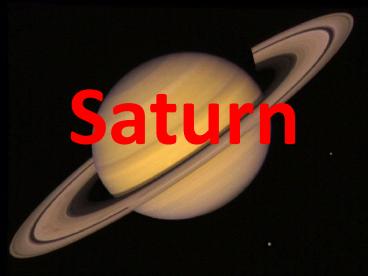Saturn - PowerPoint PPT Presentation
1 / 19
Title:
Saturn
Description:
All three layers are thicker than on Jupiter. Atmospheric Coloration. Longitudinal Bands ... Realized in 1659 (Christian Huygens) to be a flat ring system ... – PowerPoint PPT presentation
Number of Views:27
Avg rating:3.0/5.0
Title: Saturn
1
Saturn
2
Bulk Properties
- Radius 9.5 Earth radii
- Mass 95 Earth masses
- Density 0.687 g/cm3
- Semi-major Axis 9.5 A.U. (9.0-10.0)
- Orbital Period 29.5 years
- Rotational Period 10.5 hours
- Differential rotation
- Oblate spheroid (even more than Jupiter)
3
Saturns Atmosphere
- Composition
- 92 Hydrogen, 7 Helium
- Trace amounts of methane and ammonia
- Layers
- Ammonia clouds
- NH4HS clouds
- water clouds
- All three layers are thicker than on Jupiter
4
(No Transcript)
5
Atmospheric Coloration
- Longitudinal Bands
- Not as prominent as on Jupiter
- Due to thickness of the outer layer of clouds
- Weather
- Zonal flow Eastward in the zones and Westward in
the belts - Very fast winds (1500km/hr)
- Helium precipitation
- A light shower of liquid helium constantly
falling from the lower atmosphere toward the
interior
6
(No Transcript)
7
Saturns Interior
- Very similar to Jupiter
- Large rocky core
- Liquid metallic hydrogen
- Liquid molecular hydrogen
- Hydrogen/Helium atmosphere
- Magnetic field strength intermediate between
Earth and Jupiter - Large enough to contain the ring system and the
innermost 16 moons (about the orbit of Titan)
8
(No Transcript)
9
Saturns Rings
- First observed by Galileo in 1610
- Thought Saturn was a triple planet as it
appeared to have bumps or ears - Realized in 1659 (Christian Huygens) to be a flat
ring system - First ring feature (a dark band in the rings)
found in 1675 by Giovanni Cassini
10
(No Transcript)
11
Composition
- Small rocky and icy bodies
- Most about the size of a softball
- The ring system is only a few tens of meters
thick - Not one big ring, but several rings
- Original designations from outside in.
- A-ring (Contains the Encke gap)
- Cassini division
- B-ring
- C-ring
- Other rings discovered by Pioneer and Voyager
probes - Inside C-ring is the D-ring
- Outside A-ring is the F-ring and the E-ring
(faint and very far)
12
(No Transcript)
13
(No Transcript)
14
How did the rings form?
- Tidal forces increase nearer the planet
- If a body gets close enough that the tidal forces
exceed the gravitational forces holding the
object together, it breaks apart - The distance at which this happens is called the
Roche Limit - It is believed that a moon was torn apart by
tidal forces and formed the rings
15
(No Transcript)
16
Ring Maintenance
- Orbital Resonance
- A particle orbiting in the Cassini Division has
an orbital period exactly half that of Saturns
innermost major moon (Mimas) - The extra gravitational forces present at this
distance stretches the original circular orbit
into an elliptical one - This eventually clears the area of particles,
resulting in a low density gap
17
Ring Maintenance
- Shepherd Satellites
- Small moons that orbit on either side of a
ringlet - The F-ring is surrounded by the orbits of
Prometheus and Pandora - Keeps the ring tightly confined in a narrow orbit
- Moonlets
- Small moons that sweep up ring debris and create
small gaps - Pan creates the Encke gap
18
(No Transcript)
19
(No Transcript)































